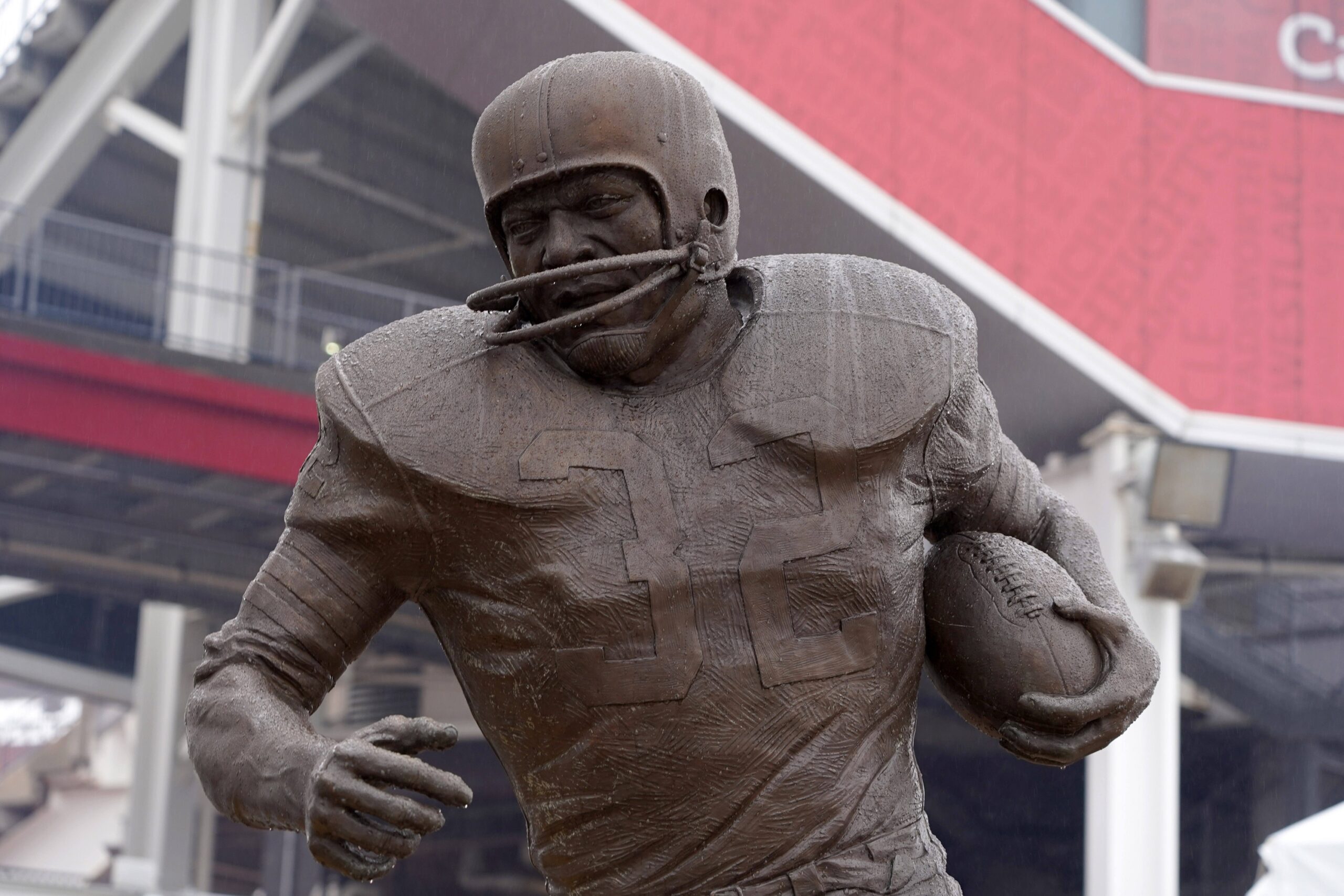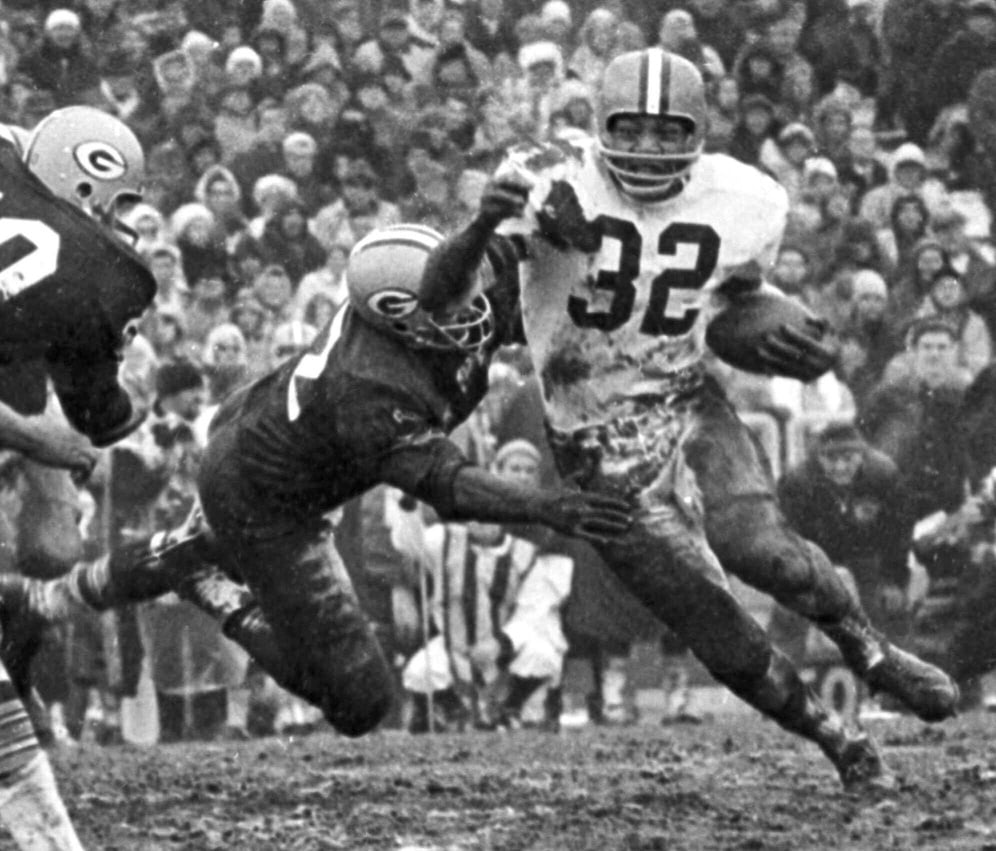Jim Brown, one of the greatest players to ever play the game, passed away at the age of 87. Brown will go down in history as one of the first player-icons in NFL history and remains a classic case of an all-star athlete excelling in multiple fields, finding ways to improve his community, and raising his profile even after establishing himself as an all-time great.
But the existence of the player-icon can be troubling, as demonstrated by Brown himself. His mark on the game will be impossible to forget, but his contributions to our understanding of the public life of athletes are much more than his play on the field, and not all of it has been positive.
Brown’s life gives us insight into all the benefits and pitfalls of the modern player-icon — a status he pioneered.
Jim Brown Established Himself as One of History’s Greatest Running Backs
It’s impossible to contextualize the impact Brown had on the field. He is, by any measure, one of — if not the — greatest running backs of all time.
Despite playing immediately after all-time great and fellow Hall of Famer Marion Motley, Brown is remembered as the iconic Cleveland running back, and with good reason; there was only one year in his nine-year career where he wasn’t a top-four vote-getter in the MVP race, and he outright won the award four times through either the Associated Press or United Press International.
Brown has eight All-Pro honors, two more than the next-most at the position (Barry Sanders), and still holds the record for most rushing yards per game with 104.3. He also averaged more than a touchdown a game, finishing his career with 106 rushing TDs and 20 receiving scores, the only player in NFL history to do so.
When the Cleveland Browns joined the NFL from the AAFC, the expectation was that they and fellow AAFC teams — the San Francisco 49ers and Baltimore Colts — would struggle in the NFL, where the best talent was. The Browns, with four consecutive AAFC Championships, had the heaviest expectations. The Browns, with Motley at running back and Otto Graham at quarterback, immediately won the NFL championship in their first season.
But after Graham and Motley retired, the Browns posted their first losing record. It wasn’t until Brown joined the team in 1957 that they could return to dominance, and in his rookie year, they immediately returned to the playoffs and made a championship appearance. They returned to the championship game twice more in Brown’s tenure, winning one of them in 1964, with Brown as the clear engine of the offense.
Brown was the first player in NFL history to break 1,500 rushing yards, setting a record in 1958 by beating the previous rushing record of 1,146 yards by earning 1,527 yards in a 12-game season. That year, Brown scored 17 touchdowns, almost double second-place Raymond Berry’s nine scores. He broke his own rushing record in 1963 with a 1,863-yard season.
Despite playing in 12-game seasons for most of his career — the NFL switched to 14 games in 1961 and 16 games in 1978 — Brown held the record for career rushing yards until 1984 when Walter Payton finally broke the mark. He still holds the record for most seasons with the all-purpose yardage lead and has the second-best season in NFL history in rushing yards per game, with his 1963 effort placing second to O.J. Simpson’s 1973 season.
Brown’s impact on the NFL from a stylistic perspective can’t be exaggerated — his preference for running through players at every opportunity, enabled by his unusual size advantage for the time, led to NFL teams preferring that kind of player for the next decade in drafts, with the average weight of a first-round running back increasing by 10 pounds from the five years prior to Brown to the five years following Brown’s selection in 1957.
Even so, it was difficult to find a running back with Browns’ dimensions; he was a 6’2″ 232-pound machine that could run through or away from defenders, and backs were coached to play with his style — even if they were not suited for it — leading to injury risk and fumble concerns. It wasn’t until the 1980s that backs willing to run out of bounds could be considered premier ball carriers.
As quarterbacks became better passers and defined franchises throughout the 1950s, Brown helped reintroduce a football culture that de-emphasized the pass and emphasized the run, limiting the exposure quarterbacks had in leading teams to wins–– a return to the style of football that dominated the 1940s. Again, it wasn’t until the 1980s that this understanding wore off, with only truly sublime talents like Johnny Unitas building the case for quarterbacks throughout the 1960s.
There will probably never be a running back to have an impact on football culture quite like Jim Brown had, but that’s only one part of his legacy — one that gets increasingly complicated the further away it ventures from on-field endeavors.

Jim Brown’s Civil Rights Legacy Won’t Be Forgotten
Like Bill Russell, Jackie Robinson, Kareem Abdul-Jabbar, and Muhammad Ali, Brown is remembered much more fondly for his civil rights activism in the aftermath instead of during.
Now, Brown is remembered for his work to make sure that accommodations for NFL players weren’t segregated while also helping break the color barrier in Hollywood as a Black lead actor — he became the first Black action hero in a major motion film in “The Dirty Dozen” (1967) and went on to play big roles in a number of movies thereafter.
He also broke barriers for positive depictions of Black-White relationships on the silver screen as well as positive depictions of Black lead actors in non-independent media.
But breaking new ground is never popular, and Brown seemed effectively blackballed after his portrayal of a loving Black husband in “100 Rifles,” disappearing entirely from the film scene in the 1970s as a figure of controversy.
Brown also brought together athletes from multiple sports to support Ali when Ali protested the Vietnam War with his refusal to be drafted. Brown, Abdul-Jabbar, and Russell led the effort to provide a unified show of support for Ali, another controversial move.
As an icon, Brown used his platform to make an effective change inside of his circle, outside of his circle, and throughout the Black community. He led the creation of the Black Economic Union, which claims to have helped over 400 Black-owned businesses get off the ground, and he continued to play a big role in reducing gang violence through his foundation “Amer-I-Can,” where he worked to rehabilitate former gang members.
His willingness to deploy his star power to the cause of social justice helped provide a model to later athlete activists like Arthur Ashe, Ann Meyers Drysdale, Mahmoud Abdul-Rauf, Colin Kaepernick, Lebron James, Brittney Griner, and Megan Rapinoe.
Jim Brown’s Alleged History of Violence Is Also Part of His Legacy
His icon status may have protected him, too. Brown had been accused of domestic violence, sexual assault and sexual battery at least six times over the course of his career, allegations which included rape and throwing a model from a balcony. He admitted in his own memoir to acts of violence against women in his life and spent time in prison for refusing to attend court-ordered domestic violence counseling after being convicted of destroying the windows of his wife’s car.
It is important to note that none of the cases resulted in a guilty verdict for domestic violence, sexual assault or sexual battery, though many of them followed the pattern we’ve become familiar with when high-profile celebrities are charged of crimes involving violence against women, with “inconsistent” testimony often used to accuse women of lying or gold-digging despite the ample psychological evidence that exists that trauma can alter memories or efforts to recount traumatic events.
The psychological phenomena of victims recanting crimes were well known to law enforcement and legal experts in the 1980s but persist today as evidence of absolution for crimes, no matter how often a subject is alleged to have committed them.
But just as one can easily draw a line between Brown’s off-field activism to the activism of modern athletes, one can draw a line between Brown’s persistent run-ins with the law and alleged misbehavior with women to modern-day athletes using their status to escape judgment or accountability.
The NFL has long had a problem with finding ways to keep players accountable for sexual assault or domestic violence, and those problems have resulted in the NFL creating new initiatives every few years to find better ways to approach the problem.
Those approaches have been ad hoc, lackluster, and disappointing. The NFL seemingly still privileges star power when doling out punishments for abuse, and they continue to engage in obsolete practices, like using inconsistent witness testimony to invalidate a claim in its entirety.
The NFL will never be able to resolve this issue in its entirety, especially as they build a system centered on bad precedent. Though Brown is not a part of the NFL’s legal disciplinary precedent, he is a part of the legacy.
Jim Brown’s Civil Rights Legacy Is Not Pristine
Brown’s civil rights legacy has also been complicated by his approach to the issue of civil rights, not just in the decades following his voluntary retirement from professional football and forced retirement from film but also during the civil rights movement itself.
A fierce advocate for empowerment-minded approaches, Brown was a critic of protest, even of Dr. Martin Luther King, telling biographer Dave Zirin in 2014, “I didn’t think much of Dr. King. I mean, I am not trying to put him down, but if you think about the majority of the rhetoric, it’s about what’s being done to us. It doesn’t have damn near anything that says what we’re going to do for ourselves.”
These were not new thoughts for Brown, who voted for Richard Nixon in 1968 despite Nixon’s disproportionately anti-Black policy agenda, one later revealed to be motivated in part by Nixon’s personal racism.
Brown was a critic of King during the civil rights movement, saying in 1963, “Dr. King is a great man because he has courage and because he has the ability to draw the masses together and move them and therefore make a tremendous contribution to the Negro restlessness, but he is a preacher and a speechmaker. I, for one, will not march down the street and kneel and pray for my rights. That is just not my shit.”
Brown advocated that Black people in the 1960s focus less on integration into housing, schools, and unions and more on building an economic base within Black communities.
This refusal to focus on structural issues in order to focus on individual development remained a consistent theme throughout his life, praising Kaepernick for his passion but arguing that instead, activists should focus on Black-on-Black crime instead of police brutality — a trope that perpetuates misconceptions about crime and race that don’t match the realities of how oppression, violence, and criminal behavior are linked.
The all-world running back certainly lived his values in that regard and undoubtedly made the world a better place through his work with the BEU and Amer-I-Can project, both of which represent his commitment to Black capitalism and a focus on gang violence. But his insistence on individual introspection rather than structural change has limited the scope of his activism.
Brown’s legacy will be remembered more for the positives than the negatives, and he remains a thunderous figure in the athletic world regardless. But he also represents the potential pitfalls of the player-icon, one whose empowerment allowed him to establish wonderful change and elide the responsibility he has to those around him and his community.

